一、MVC概要
MVC是模型(Model)、视图(View)、控制器(Controller)的简写,是一种软件设计规范,用一种将业务逻辑、数据、显示分离的方法组织代码,MVC主要作用是降低了视图与业务逻辑间的双向偶合。MVC不是一种设计模式,MVC是一种架构模式。当然不同的MVC存在差异。

在web早期的开发中,通常采用的都是Model1。Model1中,如图所示主要分为两层,视图层和模型层。Model2把一个项目分成三部分,包括视图、控制、模型。这样不仅提高的代码的复用率与项目的扩展性,且大大降低了项目的维护成本。Model 1模式的实现比较简单,适用于快速开发小规模项目,Model1中JSP页面身兼View和Controller两种角色,将控制逻辑和表现逻辑混杂在一起,从而导致代码的重用性非常低,增加了应用的扩展性和维护的难度。Model2消除了Model1的缺点。

Model1

Model1 的时序图

Model2
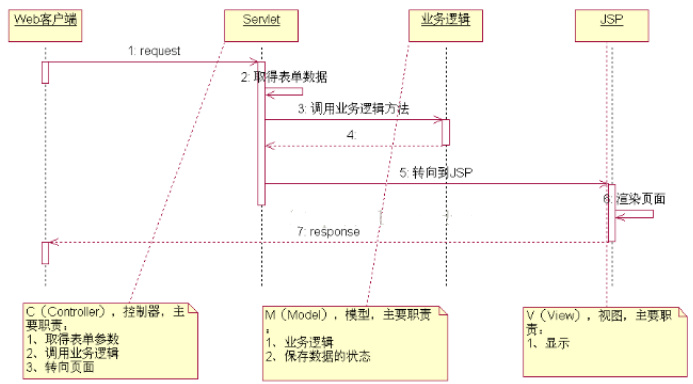
Model2的时序图
1、Model1适合小型项目开发,结构简单,开发迅速。但是JSP页面相对复杂,不利于维护。
2、Model2适合大型项目开发,职责明确,而且适应变动的需求,目的是可复用、可扩展、可维护。
3、从模型上和时序图上很容易看出,Model2是在Model1的基础上,分离了控制,将业务逻辑处理分离出来。这样Model2相对来说便于维护。
常见的服务器端MVC框架有:Struts、Spring MVC、ASP.NET MVC、Zend Framework、JSF;常见前端MVC框架:vue、angularjs、react、backbone;由MVC演化出了另外一些模式如:MVP、MVVM。
二、Spring MVC介绍
Spring MVC是Spring Framework的一部分,是基于Java实现MVC的轻量级Web框架。Spring MVC的特点:
1、轻量
2、高效
3、与Spring兼容性好
4、功能强大
RESTful、数据验证、格式化、绑定机制、本地化、主题等
5、简洁灵活

Spring的web框架围绕DispatcherServlet设计。 DispatcherServlet的作用是将请求分发到不同的处理器。从Spring 2.5开始,使用Java 5或者以上版本的用户可以采用基于注解的controller声明方式。官网上说Spring的web模块提供了大量独特的功能,包括:
清晰的角色划分:控制器(controller)、验证器(validator)、 命令对象(command object)、表单对象(form object)、模型对象(model object)、 Servlet分发器(DispatcherServlet)、 处理器映射(handler mapping)、视图解析器(view resolver)等等。 每一个角色都可以由一个专门的对象来实现。
强大而直接的配置方式:将框架类和应用程序类都能作为JavaBean配置,支持跨多个context的引用,例如,在web控制器中对业务对象和验证器(validator)的引用。
可适配、非侵入:可以根据不同的应用场景,选择合适的控制器子类 (simple型、command型、form型、wizard型、multi-action型或者自定义),而不是从单一控制器 (比如Action/ActionForm)继承。
可重用的业务代码:可以使用现有的业务对象作为命令或表单对象,而不需要去扩展某个特定框架的基类。
可定制的绑定(binding) 和验证(validation):比如将类型不匹配作为应用级的验证错误, 这可以保存错误的值。再比如本地化的日期和数字绑定等等。在其他某些框架中,你只能使用字符串表单对象, 需要手动解析它并转换到业务对象。
可定制的handler mapping和view resolution:Spring提供从最简单的URL映射, 到复杂的、专用的定制策略。与某些web MVC框架强制开发人员使用单一特定技术相比,Spring显得更加灵活。
灵活的model转换:在Springweb框架中,使用基于Map的 键/值对来达到轻易地与各种视图技术的集成。
可定制的本地化和主题(theme)解析:支持在JSP中可选择地使用Spring标签库、支持JSTL、支持Velocity(不需要额外的中间层)等等。
简单而强大的JSP标签库(Spring Tag Library):支持包括诸如数据绑定和主题(theme) 之类的许多功能。它提供在标记方面的最大灵活性。
JSP表单标签库:在Spring2.0中引入的表单标签库,使得在JSP中编写 表单更加容易。
Spring Bean的生命周期可以被限制在当前的HTTP Request或者HTTP Session。 准确的说,这并非Spring MVC框架本身特性,而应归属于Sping MVC使用的WebApplicationContext容器。
三、第一个Spring MVC 项目:Hello World(Eclipse版)
3.1、通过Maven新建一个Web项目
在Eclipse中新建Maven项目,选择“Create a simple project”,创建一个简单项目,不选择模板。
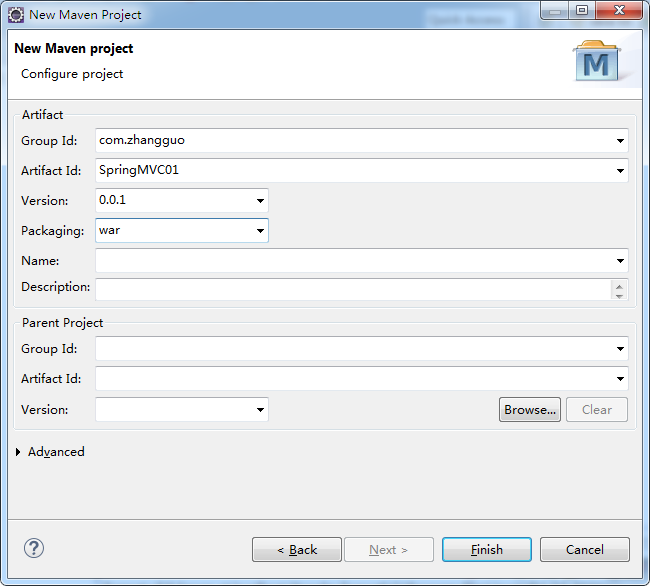
修改层面信息,更加详细的内容请参考前面写过的文章:
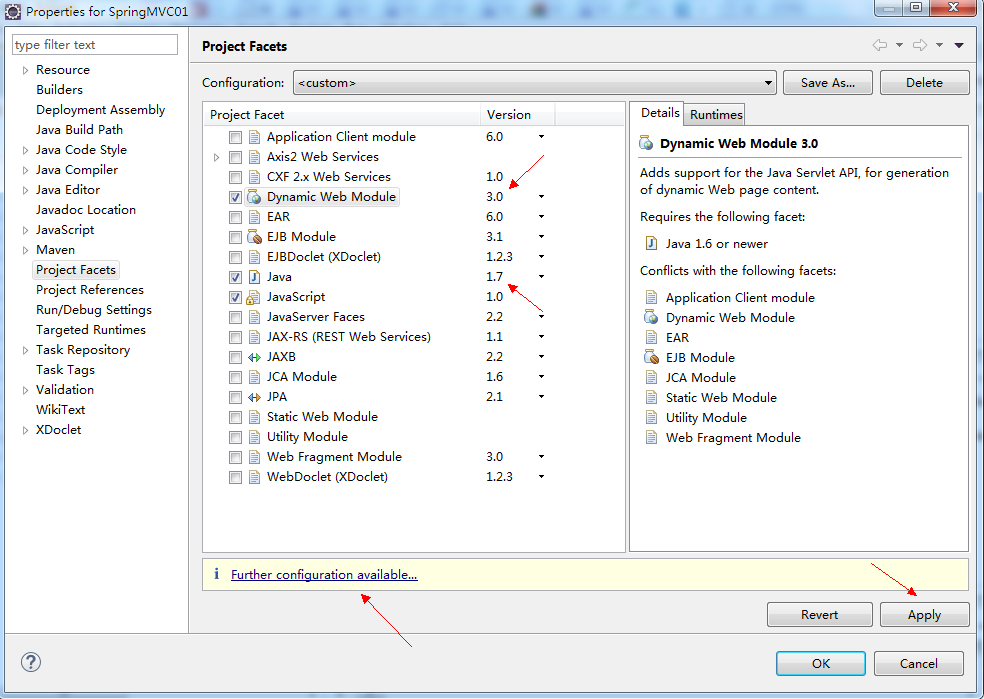
将webcontent中的所有内容复制到webapp目录下,并删除webContent目录,删除后的结果如下:
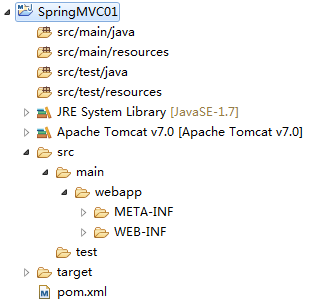
修改项目的部署信息,删除测试文件夹,添加webapp为项目根目录:
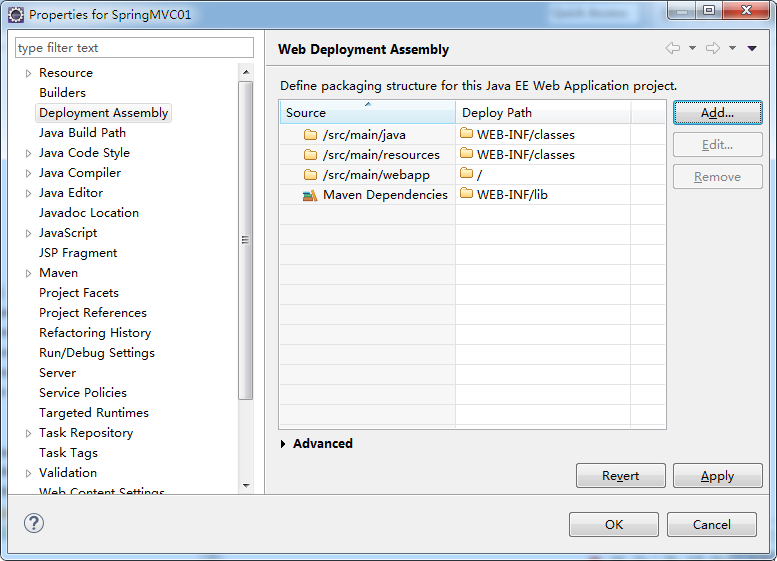
如果不打算在pom.xml中添加对Server runtime的依赖,则这里必须手动添加依赖,如下图所示:
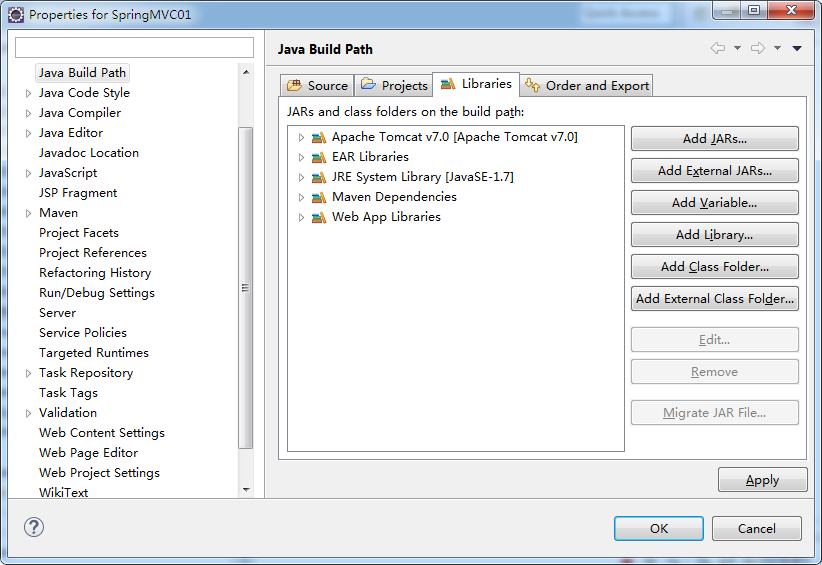
另外如果pom.xml报错,修改任意位置保存。
3.2、添加依赖的jar包
1、修改pom.xml文件、添加jar包的依赖,主要有:Spring框架核心库、Spring MVC、JSTL等,具体信息如下:
<project xmlns="http://maven.apache.org/POM/4.0.0" xmlns:xsi="http://www.w3.org/2001/XMLSchema-instance"
xsi:schemaLocation="http://maven.apache.org/POM/4.0.0 http://maven.apache.org/xsd/maven-4.0.0.xsd">
<modelVersion>4.0.0</modelVersion>
<groupId>com.zhangguo</groupId>
<artifactId>SpringMVC01</artifactId>
<version>0.0.1</version>
<packaging>war</packaging>
<properties>
<project.build.sourceEncoding>UTF-8</project.build.sourceEncoding>
<spring.version>4.3.0.RELEASE</spring.version>
</properties>
<dependencies>
<!--Spring框架核心库 -->
<dependency>
<groupId>org.springframework</groupId>
<artifactId>spring-context</artifactId>
<version>${spring.version}</version>
</dependency>
<!-- Spring MVC -->
<dependency>
<groupId>org.springframework</groupId>
<artifactId>spring-webmvc</artifactId>
<version>${spring.version}</version>
</dependency>
<!-- JSTL -->
<dependency>
<groupId>javax.servlet</groupId>
<artifactId>jstl</artifactId>
<version>1.2</version>
</dependency>
</dependencies>
</project>
当依赖成功时,会加载的jar包如下:
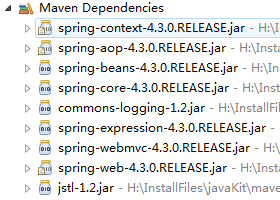
3.3、修改web.xml注册中心控制器DispatcherServlet
Spring MVC框架像许多其他MVC框架一样, 请求驱动,围绕一个中心Servlet分派请求及提供其他功能,DispatcherServlet是一个实际的Servlet (它继承自HttpServlet 基类)。如下图所示当发起请求时被前置的控制器拦截到请求,根据请求参数生成代理请求,找到请求对应的实际控制器,控制器处理请求,创建数据模型,访问数据库,将模型响应给中心控制器,控制器使用模型与视图渲染视图结果,将结果返回给中心控制器,再将结果返回给请求者。


修改web.xml文件注册该Servlet,修改后的web.xml文件如下:
<?xml version="1.0" encoding="UTF-8"?>
<web-app xmlns:xsi="http://www.w3.org/2001/XMLSchema-instance"
xmlns="http://java.sun.com/xml/ns/javaee"
xsi:schemaLocation="http://java.sun.com/xml/ns/javaee http://java.sun.com/xml/ns/javaee/web-app_3_0.xsd"
id="WebApp_ID" version="3.0">
<servlet>
<!--名称 -->
<servlet-name>springmvc</servlet-name>
<!-- Servlet类 -->
<servlet-class>org.springframework.web.servlet.DispatcherServlet</servlet-class>
<!-- 启动顺序,数字越小,启动越早 -->
<load-on-startup>1</load-on-startup>
<init-param>
<!--SpringMVC配置参数文件的位置 -->
<param-name>contextConfigLocation</param-name>
<!--默认名称为ServletName-servlet.xml -->
<param-value>classpath*:springmvc-servlet.xml</param-value>
</init-param>
</servlet>
<!--所有请求都会被springmvc拦截 -->
<servlet-mapping>
<servlet-name>springmvc</servlet-name>
<url-pattern>/</url-pattern>
</servlet-mapping>
</web-app>
3.4、添加Spring MVC配置文件
在src/main/java源代码目录下添加springmvc-servlet.xml配置文件,配置的形式与Spring容器配置基本类似,为了支持基于注解的IOC,设置了自动扫描包的功能,具体配置信息如下:
<?xml version="1.0" encoding="UTF-8"?>
<beans xmlns="http://www.springframework.org/schema/beans"
xmlns:xsi="http://www.w3.org/2001/XMLSchema-instance"
xmlns:context="http://www.springframework.org/schema/context"
xmlns:mvc="http://www.springframework.org/schema/mvc"
xsi:schemaLocation="http://www.springframework.org/schema/beans
http://www.springframework.org/schema/beans/spring-beans.xsd
http://www.springframework.org/schema/context
http://www.springframework.org/schema/context/spring-context-4.3.xsd
http://www.springframework.org/schema/mvc
http://www.springframework.org/schema/mvc/spring-mvc-4.3.xsd">
<!-- 自动扫描包,实现支持注解的IOC -->
<context:component-scan base-package="com.zhangguo.springmvc01" />
<!-- Spring MVC不处理静态资源 -->
<mvc:default-servlet-handler />
<!-- 支持mvc注解驱动 -->
<mvc:annotation-driven />
<!-- 视图解析器 -->
<bean
class="org.springframework.web.servlet.view.InternalResourceViewResolver"
id="internalResourceViewResolver">
<!-- 前缀 -->
<property name="prefix" value="/WEB-INF/view/" />
<!-- 后缀 -->
<property name="suffix" value=".jsp" />
</bean>
</beans>
在视图解析中我们把所有的视图都存放在/WEB-INF/目录下,这样是为了视图安全,因为这个目录客户端不能直接访问。
mvc:annotation-driven:
在spring中一般采用@RequestMapping注解来完成映射关系,要想使@RequestMapping注解生效必须向上下文中注册DefaultAnnotationHandlerMapping和一个AnnotationMethodHandlerAdapter实例,这两个实例分别在类级别和方法级别处理。而annotation-driven配置帮助我们自动完成上述两个实例的注入。
3.5、创建HelloWorld控制器
在src/main/java源代码目录下创建包com.zhangguo.springmvc01.controller,在包下创建一个普通的类:HelloWorld,具体代码如下:
package com.zhangguo.springmvc01.controller;
import org.springframework.stereotype.Controller;
import org.springframework.ui.Model;
import org.springframework.web.bind.annotation.RequestMapping;
@Controller
@RequestMapping("/Hello")
public class HelloWorld {
@RequestMapping("/Sayhi")
public String SayHi(Model model) {
model.addAttribute("message", "Hello Spring MVC!");
return "sayhi";
}
}
注解为@Controller是为了让Spring IOC容器初始化时自动扫描到;@RequestMapping是为了映射请求路径,这里因为类与方法上都有映射所以访问时应该是/Hello/Sayhi;方法中声明Model类型的参数是为了把Action中的数据带到视图中;方法返回的结果是视图的名称sayhi。
3.6、创建视图
在WEB-INF/view目录中创建视图,视图将从Action中带回的信息展示,具体内容如下:
<%@ page language="java" contentType="text/html; charset=UTF-8" pageEncoding="UTF-8"%>
<%@ taglib prefix="c" uri="http://java.sun.com/jsp/jstl/core" %>
<!DOCTYPE html>
<html>
<head>
<meta http-equiv="Content-Type" content="text/html; charset=UTF-8">
<title>Hello Spring MVC!</title>
</head>
<body>
<h2>${message}</h2>
</body>
</html>
3.7、测试运行
启动Tomcat运行项目,请注意查看启动信息,如果有异常应该先解决异常信息,运行成功后的结果如下所示:
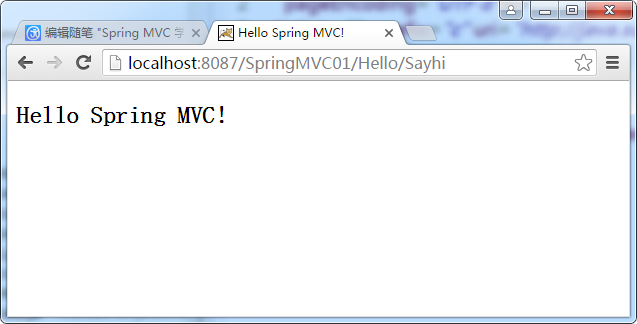
四、第一个Spring MVC 项目:Hello World(IDEA)
4.1、在IDEA中使用Maven根据WebApp骨架创建一个项目
在Idea中新建Maven项目,选择“org.apache.maven.archetypes:maven-archetype-webapp”骨架(模板),创建一个Web项目:
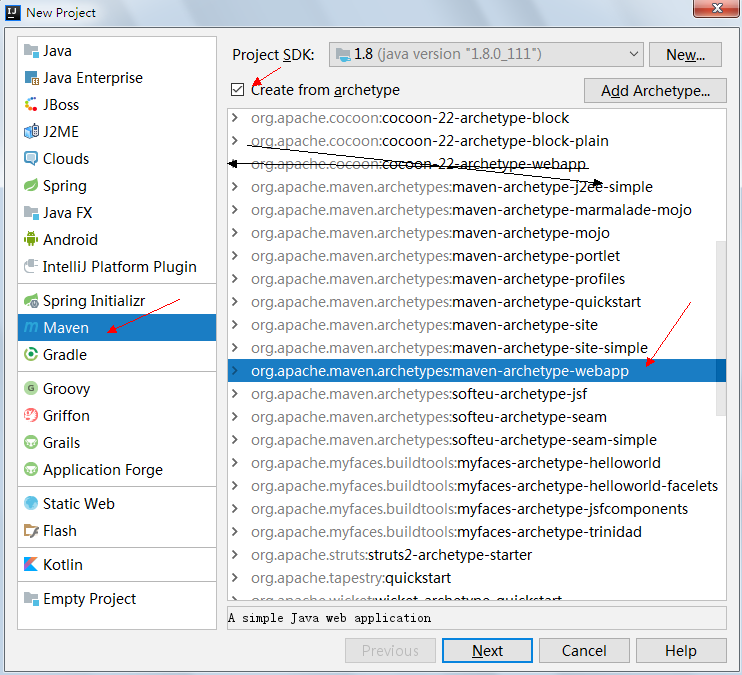
输入项目的坐标:
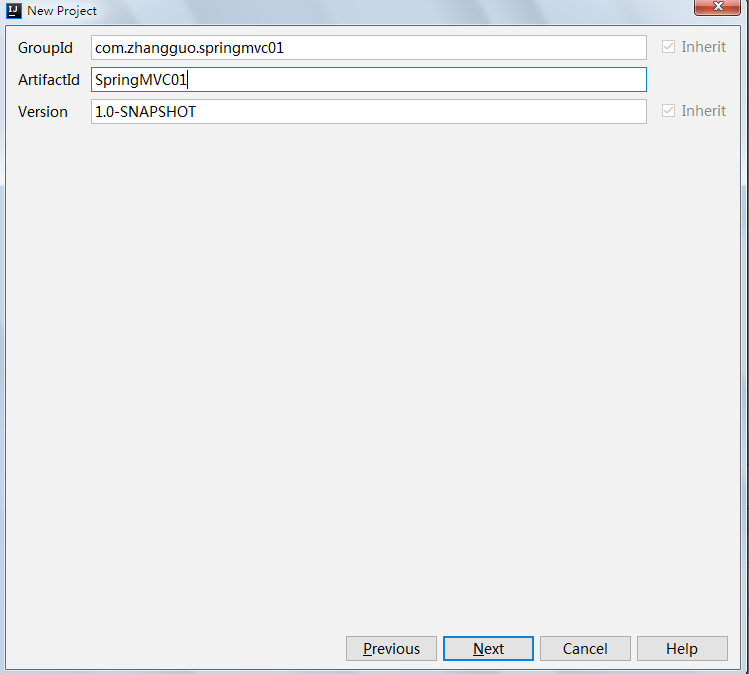
选择仓库位置与配置信息,建议使用默认设置(先使用IDEA的默认设置将Maven配置好)
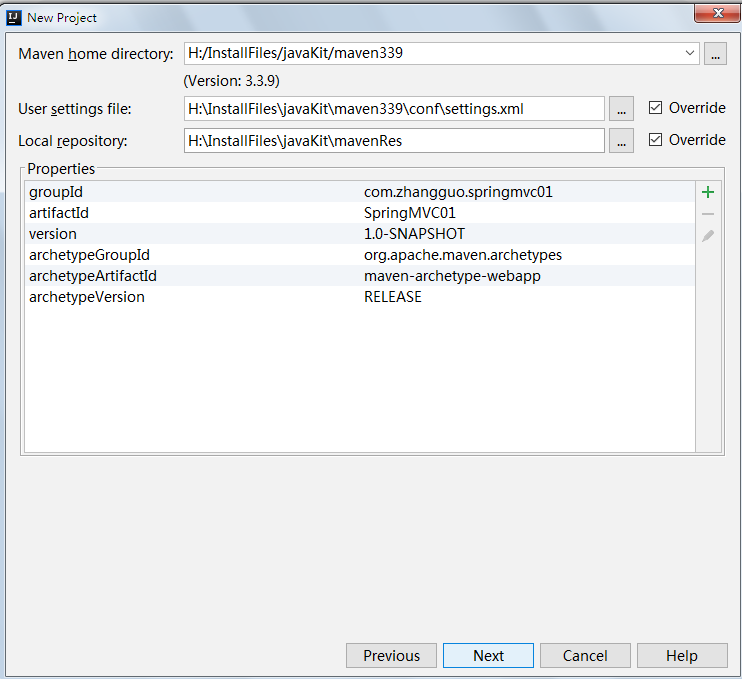
设置项目位置,完成即可
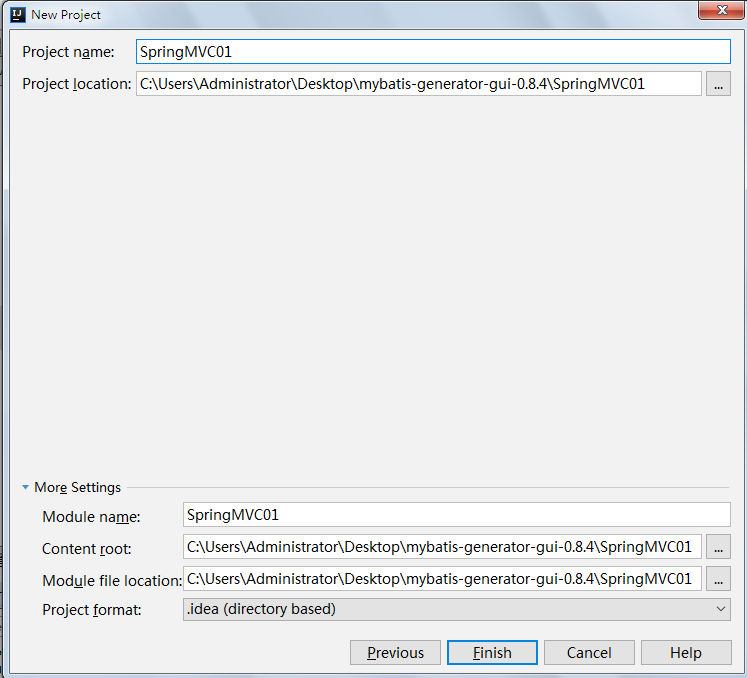
初始化的项目如下:
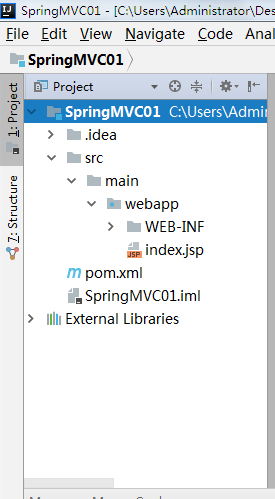
根据Maven规范,需要创建源代码、资源与测试目录:

在main上右键创建java目录、resources目录,创建与main平级的test测试目录:

设置目录的特殊属性:
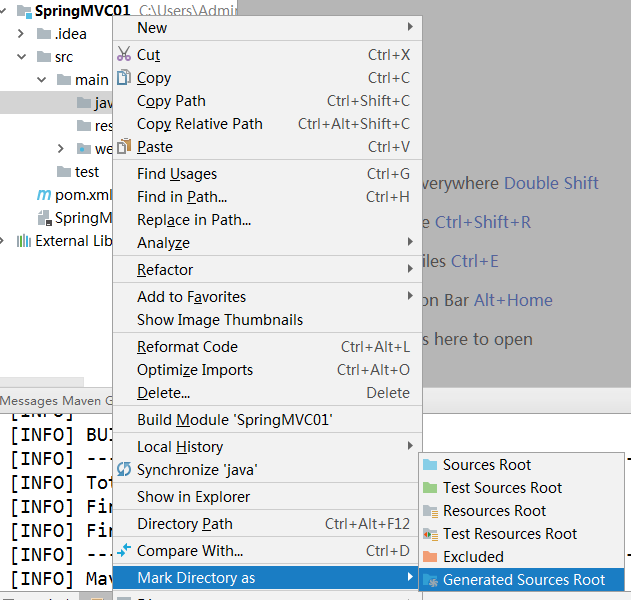
设置完成后的结果:
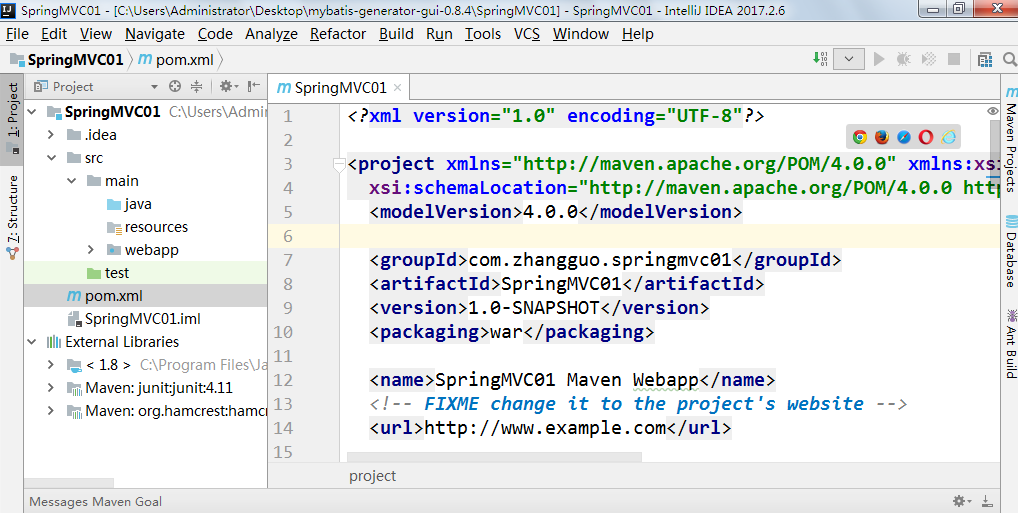
4.2、添加依赖的jar包
1、修改pom.xml文件、添加jar包的依赖,主要有:Spring框架核心库、Spring MVC、JSTL等,具体信息如下:
<?xml version="1.0" encoding="UTF-8"?>
<project xmlns="http://maven.apache.org/POM/4.0.0" xmlns:xsi="http://www.w3.org/2001/XMLSchema-instance"
xsi:schemaLocation="http://maven.apache.org/POM/4.0.0 http://maven.apache.org/xsd/maven-4.0.0.xsd">
<modelVersion>4.0.0</modelVersion>
<groupId>com.zhangguo.springmvc01</groupId>
<artifactId>SpringMVC01</artifactId>
<version>1.0-SNAPSHOT</version>
<packaging>war</packaging>
<name>SpringMVC01 Maven Webapp</name>
<!-- FIXME change it to the project's website -->
<url>http://www.example.com</url>
<properties>
<project.build.sourceEncoding>UTF-8</project.build.sourceEncoding>
<maven.compiler.source>1.7</maven.compiler.source>
<maven.compiler.target>1.7</maven.compiler.target>
<spring.version>4.3.0.RELEASE</spring.version>
</properties>
<dependencies>
<dependency>
<groupId>junit</groupId>
<artifactId>junit</artifactId>
<version>4.11</version>
<scope>test</scope>
</dependency>
<!--Spring框架核心库 -->
<dependency>
<groupId>org.springframework</groupId>
<artifactId>spring-context</artifactId>
<version>${spring.version}</version>
</dependency>
<!-- Spring MVC -->
<dependency>
<groupId>org.springframework</groupId>
<artifactId>spring-webmvc</artifactId>
<version>${spring.version}</version>
</dependency>
<!--Servlet核心-->
<dependency>
<groupId>javax.servlet</groupId>
<artifactId>javax.servlet-api</artifactId>
<version>3.0.1</version>
<scope>provided</scope>
</dependency>
<!-- JSTL -->
<dependency>
<groupId>javax.servlet</groupId>
<artifactId>jstl</artifactId>
<version>1.2</version>
</dependency>
</dependencies>
<build>
<finalName>SpringMVC01</finalName>
<pluginManagement><!-- lock down plugins versions to avoid using Maven defaults (may be moved to parent pom) -->
<plugins>
<plugin>
<artifactId>maven-clean-plugin</artifactId>
<version>3.0.0</version>
</plugin>
<!-- see http://maven.apache.org/ref/current/maven-core/default-bindings.html#Plugin_bindings_for_war_packaging -->
<plugin>
<artifactId>maven-resources-plugin</artifactId>
<version>3.0.2</version>
</plugin>
<plugin>
<artifactId>maven-compiler-plugin</artifactId>
<version>3.7.0</version>
</plugin>
<plugin>
<artifactId>maven-surefire-plugin</artifactId>
<version>2.20.1</version>
</plugin>
<plugin>
<artifactId>maven-war-plugin</artifactId>
<version>3.2.0</version>
</plugin>
<plugin>
<artifactId>maven-install-plugin</artifactId>
<version>2.5.2</version>
</plugin>
<plugin>
<artifactId>maven-deploy-plugin</artifactId>
<version>2.8.2</version>
</plugin>
</plugins>
</pluginManagement>
</build>
</project>
当依赖成功时,会加载的jar包如下:
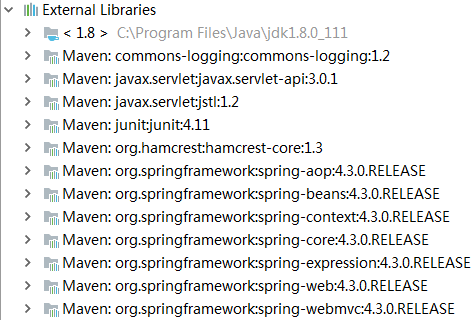
4.3、修改web.xml注册中心控制器DispatcherServlet
Spring MVC框架像许多其他MVC框架一样, 请求驱动,围绕一个中心Servlet分派请求及提供其他功能,DispatcherServlet是一个实际的Servlet (它继承自HttpServlet 基类)。如下图所示当发起请求时被前置的控制器拦截到请求,根据请求参数生成代理请求,找到请求对应的实际控制器,控制器处理请求,创建数据模型,访问数据库,将模型响应给中心控制器,控制器使用模型与视图渲染视图结果,将结果返回给中心控制器,再将结果返回给请求者。


Spring MVC中心控制器的源码如下:

/*
* Copyright 2002-2016 the original author or authors.
*
* Licensed under the Apache License, Version 2.0 (the "License");
* you may not use this file except in compliance with the License.
* You may obtain a copy of the License at
*
* http://www.apache.org/licenses/LICENSE-2.0
*
* Unless required by applicable law or agreed to in writing, software
* distributed under the License is distributed on an "AS IS" BASIS,
* WITHOUT WARRANTIES OR CONDITIONS OF ANY KIND, either express or implied.
* See the License for the specific language governing permissions and
* limitations under the License.
*/
package org.springframework.web.servlet;
import java.io.IOException;
import java.util.ArrayList;
import java.util.Collections;
import java.util.Enumeration;
import java.util.HashMap;
import java.util.HashSet;
import java.util.LinkedList;
import java.util.List;
import java.util.Locale;
import java.util.Map;
import java.util.Properties;
import java.util.Set;
import javax.servlet.ServletContext;
import javax.servlet.ServletException;
import javax.servlet.http.HttpServletRequest;
import javax.servlet.http.HttpServletResponse;
import org.apache.commons.logging.Log;
import org.apache.commons.logging.LogFactory;
import org.springframework.beans.factory.BeanFactoryUtils;
import org.springframework.beans.factory.BeanInitializationException;
import org.springframework.beans.factory.NoSuchBeanDefinitionException;
import org.springframework.context.ApplicationContext;
import org.springframework.context.ConfigurableApplicationContext;
import org.springframework.context.i18n.LocaleContext;
import org.springframework.core.annotation.AnnotationAwareOrderComparator;
import org.springframework.core.io.ClassPathResource;
import org.springframework.core.io.support.PropertiesLoaderUtils;
import org.springframework.http.server.ServletServerHttpRequest;
import org.springframework.ui.context.ThemeSource;
import org.springframework.util.ClassUtils;
import org.springframework.util.StringUtils;
import org.springframework.web.context.WebApplicationContext;
import org.springframework.web.context.request.ServletWebRequest;
import org.springframework.web.context.request.async.WebAsyncManager;
import org.springframework.web.context.request.async.WebAsyncUtils;
import org.springframework.web.multipart.MultipartException;
import org.springframework.web.multipart.MultipartHttpServletRequest;
import org.springframework.web.multipart.MultipartResolver;
import org.springframework.web.util.NestedServletException;
import org.springframework.web.util.WebUtils;
/**
* Central dispatcher for HTTP request handlers/controllers, e.g. for web UI controllers
* or HTTP-based remote service exporters. Dispatches to registered handlers for processing
* a web request, providing convenient mapping and exception handling facilities.
*
* <p>This servlet is very flexible: It can be used with just about any workflow, with the
* installation of the appropriate adapter classes. It offers the following functionality
* that distinguishes it from other request-driven web MVC frameworks:
*
* <ul>
* <li>It is based around a JavaBeans configuration mechanism.
*
* <li>It can use any {@link HandlerMapping} implementation - pre-built or provided as part
* of an application - to control the routing of requests to handler objects. Default is
* {@link org.springframework.web.servlet.handler.BeanNameUrlHandlerMapping} and
* {@link org.springframework.web.servlet.mvc.annotation.DefaultAnnotationHandlerMapping}.
* HandlerMapping objects can be defined as beans in the servlet's application context,
* implementing the HandlerMapping interface, overriding the default HandlerMapping if
* present. HandlerMappings can be given any bean name (they are tested by type).
*
* <li>It can use any {@link HandlerAdapter}; this allows for using any handler interface.
* Default adapters are {@link org.springframework.web.servlet.mvc.HttpRequestHandlerAdapter},
* {@link org.springframework.web.servlet.mvc.SimpleControllerHandlerAdapter}, for Spring's
* {@link org.springframework.web.HttpRequestHandler} and
* {@link org.springframework.web.servlet.mvc.Controller} interfaces, respectively. A default
* {@link org.springframework.web.servlet.mvc.annotation.AnnotationMethodHandlerAdapter}
* will be registered as well. HandlerAdapter objects can be added as beans in the
* application context, overriding the default HandlerAdapters. Like HandlerMappings,
* HandlerAdapters can be given any bean name (they are tested by type).
*
* <li>The dispatcher's exception resolution strategy can be specified via a
* {@link HandlerExceptionResolver}, for example mapping certain exceptions to error pages.
* Default are
* {@link org.springframework.web.servlet.mvc.annotation.AnnotationMethodHandlerExceptionResolver},
* {@link org.springframework.web.servlet.mvc.annotation.ResponseStatusExceptionResolver}, and
* {@link org.springframework.web.servlet.mvc.support.DefaultHandlerExceptionResolver}.
* These HandlerExceptionResolvers can be overridden through the application context.
* HandlerExceptionResolver can be given any bean name (they are tested by type).
*
* <li>Its view resolution strategy can be specified via a {@link ViewResolver}
* implementation, resolving symbolic view names into View objects. Default is
* {@link org.springframework.web.servlet.view.InternalResourceViewResolver}.
* ViewResolver objects can be added as beans in the application context, overriding the
* default ViewResolver. ViewResolvers can be given any bean name (they are tested by type).
*
* <li>If a {@link View} or view name is not supplied by the user, then the configured
* {@link RequestToViewNameTranslator} will translate the current request into a view name.
* The corresponding bean name is "viewNameTranslator"; the default is
* {@link org.springframework.web.servlet.view.DefaultRequestToViewNameTranslator}.
*
* <li>The dispatcher's strategy for resolving multipart requests is determined by a
* {@link org.springframework.web.multipart.MultipartResolver} implementation.
* Implementations for Apache Commons FileUpload and Servlet 3 are included; the typical
* choice is {@link org.springframework.web.multipart.commons.CommonsMultipartResolver}.
* The MultipartResolver bean name is "multipartResolver"; default is none.
*
* <li>Its locale resolution strategy is determined by a {@link LocaleResolver}.
* Out-of-the-box implementations work via HTTP accept header, cookie, or session.
* The LocaleResolver bean name is "localeResolver"; default is
* {@link org.springframework.web.servlet.i18n.AcceptHeaderLocaleResolver}.
*
* <li>Its theme resolution strategy is determined by a {@link ThemeResolver}.
* Implementations for a fixed theme and for cookie and session storage are included.
* The ThemeResolver bean name is "themeResolver"; default is
* {@link org.springframework.web.servlet.theme.FixedThemeResolver}.
* </ul>
*
* <p><b>NOTE: The {@code @RequestMapping} annotation will only be processed if a
* corresponding {@code HandlerMapping} (for type-level annotations) and/or
* {@code HandlerAdapter} (for method-level annotations) is present in the dispatcher.</b>
* This is the case by default. However, if you are defining custom {@code HandlerMappings}
* or {@code HandlerAdapters}, then you need to make sure that a corresponding custom
* {@code DefaultAnnotationHandlerMapping} and/or {@code AnnotationMethodHandlerAdapter}
* is defined as well - provided that you intend to use {@code @RequestMapping}.
*
* <p><b>A web application can define any number of DispatcherServlets.</b>
* Each servlet will operate in its own namespace, loading its own application context
* with mappings, handlers, etc. Only the root application context as loaded by
* {@link org.springframework.web.context.ContextLoaderListener}, if any, will be shared.
*
* <p>As of Spring 3.1, {@code DispatcherServlet} may now be injected with a web
* application context, rather than creating its own internally. This is useful in Servlet
* 3.0+ environments, which support programmatic registration of servlet instances.
* See the {@link #DispatcherServlet(WebApplicationContext)} javadoc for details.
*
* @author Rod Johnson
* @author Juergen Hoeller
* @author Rob Harrop
* @author Chris Beams
* @author Rossen Stoyanchev
* @see org.springframework.web.HttpRequestHandler
* @see org.springframework.web.servlet.mvc.Controller
* @see org.springframework.web.context.ContextLoaderListener
*/
@SuppressWarnings("serial")
public class DispatcherServlet extends FrameworkServlet {
/** Well-known name for the MultipartResolver object in the bean factory for this namespace. */
public static final String MULTIPART_RESOLVER_BEAN_NAME = "multipartResolver";
/** Well-known name for the LocaleResolver object in the bean factory for this namespace. */
public static final String LOCALE_RESOLVER_BEAN_NAME = "localeResolver";
/** Well-known name for the ThemeResolver object in the bean factory for this namespace. */
public static final String THEME_RESOLVER_BEAN_NAME = "themeResolver";
/**
* Well-known name for the HandlerMapping object in the bean factory for this namespace.
* Only used when "detectAllHandlerMappings" is turned off.
* @see #setDetectAllHandlerMappings
*/
public static final String HANDLER_MAPPING_BEAN_NAME = "handlerMapping";
/**
* Well-known name for the HandlerAdapter object in the bean factory for this namespace.
* Only used when "detectAllHandlerAdapters" is turned off.
* @see #setDetectAllHandlerAdapters
*/
public static final String HANDLER_ADAPTER_BEAN_NAME = "handlerAdapter";
/**
* Well-known name for the HandlerExceptionResolver object in the bean factory for this namespace.
* Only used when "detectAllHandlerExceptionResolvers" is turned off.
* @see #setDetectAllHandlerExceptionResolvers
*/
public static final String HANDLER_EXCEPTION_RESOLVER_BEAN_NAME = "handlerExceptionResolver";
/**
* Well-known name for the RequestToViewNameTranslator object in the bean factory for this namespace.
*/
public static final String REQUEST_TO_VIEW_NAME_TRANSLATOR_BEAN_NAME = "viewNameTranslator";
/**
* Well-known name for the ViewResolver object in the bean factory for this namespace.
* Only used when "detectAllViewResolvers" is turned off.
* @see #setDetectAllViewResolvers
*/
public static final String VIEW_RESOLVER_BEAN_NAME = "viewResolver";
/**
* Well-known name for the FlashMapManager object in the bean factory for this namespace.
*/
public static final String FLASH_MAP_MANAGER_BEAN_NAME = "flashMapManager";
/**
* Request attribute to hold the current web application context.
* Otherwise only the global web app context is obtainable by tags etc.
* @see org.springframework.web.servlet.support.RequestContextUtils#findWebApplicationContext
*/
public static final String WEB_APPLICATION_CONTEXT_ATTRIBUTE = DispatcherServlet.class.getName() + ".CONTEXT";
/**
* Request attribute to hold the current LocaleResolver, retrievable by views.
* @see org.springframework.web.servlet.support.RequestContextUtils#getLocaleResolver
*/
public static final String LOCALE_RESOLVER_ATTRIBUTE = DispatcherServlet.class.getName() + ".LOCALE_RESOLVER";
/**
* Request attribute to hold the current ThemeResolver, retrievable by views.
* @see org.springframework.web.servlet.support.RequestContextUtils#getThemeResolver
*/
public static final String THEME_RESOLVER_ATTRIBUTE = DispatcherServlet.class.getName() + ".THEME_RESOLVER";
/**
* Request attribute to hold the current ThemeSource, retrievable by views.
* @see org.springframework.web.servlet.support.RequestContextUtils#getThemeSource
*/
public static final String THEME_SOURCE_ATTRIBUTE = DispatcherServlet.class.getName() + ".THEME_SOURCE";
/**
* Name of request attribute that holds a read-only {@code Map<String,?>}
* with "input" flash attributes saved by a previous request, if any.
* @see org.springframework.web.servlet.support.RequestContextUtils#getInputFlashMap(HttpServletRequest)
*/
public static final String INPUT_FLASH_MAP_ATTRIBUTE = DispatcherServlet.class.getName() + ".INPUT_FLASH_MAP";
/**
* Name of request attribute that holds the "output" {@link FlashMap} with
* attributes to save for a subsequent request.
* @see org.springframework.web.servlet.support.RequestContextUtils#getOutputFlashMap(HttpServletRequest)
*/
public static final String OUTPUT_FLASH_MAP_ATTRIBUTE = DispatcherServlet.class.getName() + ".OUTPUT_FLASH_MAP";
/**
* Name of request attribute that holds the {@link FlashMapManager}.
* @see org.springframework.web.servlet.support.RequestContextUtils#getFlashMapManager(HttpServletRequest)
*/
public static final String FLASH_MAP_MANAGER_ATTRIBUTE = DispatcherServlet.class.getName() + ".FLASH_MAP_MANAGER";
/**
* Name of request attribute that exposes an Exception resolved with an
* {@link HandlerExceptionResolver} but where no view was rendered
* (e.g. setting the status code).
*/
public static final String EXCEPTION_ATTRIBUTE = DispatcherServlet.class.getName() + ".EXCEPTION";
/** Log category to use when no mapped handler is found for a request. */
public static final String PAGE_NOT_FOUND_LOG_CATEGORY = "org.springframework.web.servlet.PageNotFound";
/**
* Name of the class path resource (relative to the DispatcherServlet class)
* that defines DispatcherServlet's default strategy names.
*/
private static final String DEFAULT_STRATEGIES_PATH = "DispatcherServlet.properties";
/** Additional logger to use when no mapped handler is found for a request. */
protected static final Log pageNotFoundLogger = LogFactory.getLog(PAGE_NOT_FOUND_LOG_CATEGORY);
private static final Properties defaultStrategies;
static {
// Load default strategy implementations from properties file.
// This is currently strictly internal and not meant to be customized
// by application developers.
try {
ClassPathResource resource = new ClassPathResource(DEFAULT_STRATEGIES_PATH, DispatcherServlet.class);
defaultStrategies = PropertiesLoaderUtils.loadProperties(resource);
}
catch (IOException ex) {
throw new IllegalStateException("Could not load 'DispatcherServlet.properties': " + ex.getMessage());
}
}
/** Detect all HandlerMappings or just expect "handlerMapping" bean? */
private boolean detectAllHandlerMappings = true;
/** Detect all HandlerAdapters or just expect "handlerAdapter" bean? */
private boolean detectAllHandlerAdapters = true;
/** Detect all HandlerExceptionResolvers or just expect "handlerExceptionResolver" bean? */
private boolean detectAllHandlerExceptionResolvers = true;
/** Detect all ViewResolvers or just expect "viewResolver" bean? */
private boolean detectAllViewResolvers = true;
/** Throw a NoHandlerFoundException if no Handler was found to process this request? **/
private boolean throwExceptionIfNoHandlerFound = false;
/** Perform cleanup of request attributes after include request? */
private boolean cleanupAfterInclude = true;
/** MultipartResolver used by this servlet */
private MultipartResolver multipartResolver;
/** LocaleResolver used by this servlet */
private LocaleResolver localeResolver;
/** ThemeResolver used by this servlet */
private ThemeResolver themeResolver;
/** List of HandlerMappings used by this servlet */
private List<HandlerMapping> handlerMappings;
/** List of HandlerAdapters used by this servlet */
private List<HandlerAdapter> handlerAdapters;
/** List of HandlerExceptionResolvers used by this servlet */
private List<HandlerExceptionResolver> handlerExceptionResolvers;
/** RequestToViewNameTranslator used by this servlet */
private RequestToViewNameTranslator viewNameTranslator;
/** FlashMapManager used by this servlet */
private FlashMapManager flashMapManager;
/** List of ViewResolvers used by this servlet */
private List<ViewResolver> viewResolvers;
/**
* Create a new {@code DispatcherServlet} that will create its own internal web
* application context based on defaults and values provided through servlet
* init-params. Typically used in Servlet 2.5 or earlier environments, where the only
* option for servlet registration is through {@code web.xml} which requires the use
* of a no-arg constructor.
* <p>Calling {@link #setContextConfigLocation} (init-param 'contextConfigLocation')
* will dictate which XML files will be loaded by the
* {@linkplain #DEFAULT_CONTEXT_CLASS default XmlWebApplicationContext}
* <p>Calling {@link #setContextClass} (init-param 'contextClass') overrides the
* default {@code XmlWebApplicationContext} and allows for specifying an alternative class,
* such as {@code AnnotationConfigWebApplicationContext}.
* <p>Calling {@link #setContextInitializerClasses} (init-param 'contextInitializerClasses')
* indicates which {@code ApplicationContextInitializer} classes should be used to
* further configure the internal application context prior to refresh().
* @see #DispatcherServlet(WebApplicationContext)
*/
public DispatcherServlet() {
super();
setDispatchOptionsRequest(true);
}
/**
* Create a new {@code DispatcherServlet} with the given web application context. This
* constructor is useful in Servlet 3.0+ environments where instance-based registration
* of servlets is possible through the {@link ServletContext#addServlet} API.
* <p>Using this constructor indicates that the following properties / init-params
* will be ignored:
* <ul>
* <li>{@link #setContextClass(Class)} / 'contextClass'</li>
* <li>{@link #setContextConfigLocation(String)} / 'contextConfigLocation'</li>
* <li>{@link #setContextAttribute(String)} / 'contextAttribute'</li>
* <li>{@link #setNamespace(String)} / 'namespace'</li>
* </ul>
* <p>The given web application context may or may not yet be {@linkplain
* ConfigurableApplicationContext#refresh() refreshed}. If it has <strong>not</strong>
* already been refreshed (the recommended approach), then the following will occur:
* <ul>
* <li>If the given context does not already have a {@linkplain
* ConfigurableApplicationContext#setParent parent}, the root application context
* will be set as the parent.</li>
* <li>If the given context has not already been assigned an {@linkplain
* ConfigurableApplicationContext#setId id}, one will be assigned to it</li>
* <li>{@code ServletContext} and {@code ServletConfig} objects will be delegated to
* the application context</li>
* <li>{@link #postProcessWebApplicationContext} will be called</li>
* <li>Any {@code ApplicationContextInitializer}s specified through the
* "contextInitializerClasses" init-param or through the {@link
* #setContextInitializers} property will be applied.</li>
* <li>{@link ConfigurableApplicationContext#refresh refresh()} will be called if the
* context implements {@link ConfigurableApplicationContext}</li>
* </ul>
* If the context has already been refreshed, none of the above will occur, under the
* assumption that the user has performed these actions (or not) per their specific
* needs.
* <p>See {@link org.springframework.web.WebApplicationInitializer} for usage examples.
* @param webApplicationContext the context to use
* @see #initWebApplicationContext
* @see #configureAndRefreshWebApplicationContext
* @see org.springframework.web.WebApplicationInitializer
*/
public DispatcherServlet(WebApplicationContext webApplicationContext) {
super(webApplicationContext);
setDispatchOptionsRequest(true);
}
/**
* Set whether to detect all HandlerMapping beans in this servlet's context. Otherwise,
* just a single bean with name "handlerMapping" will be expected.
* <p>Default is "true". Turn this off if you want this servlet to use a single
* HandlerMapping, despite multiple HandlerMapping beans being defined in the context.
*/
public void setDetectAllHandlerMappings(boolean detectAllHandlerMappings) {
this.detectAllHandlerMappings = detectAllHandlerMappings;
}
/**
* Set whether to detect all HandlerAdapter beans in this servlet's context. Otherwise,
* just a single bean with name "handlerAdapter" will be expected.
* <p>Default is "true". Turn this off if you want this servlet to use a single
* HandlerAdapter, despite multiple HandlerAdapter beans being defined in the context.
*/
public void setDetectAllHandlerAdapters(boolean detectAllHandlerAdapters) {
this.detectAllHandlerAdapters = detectAllHandlerAdapters;
}
/**
* Set whether to detect all HandlerExceptionResolver beans in this servlet's context. Otherwise,
* just a single bean with name "handlerExceptionResolver" will be expected.
* <p>Default is "true". Turn this off if you want this servlet to use a single
* HandlerExceptionResolver, despite multiple HandlerExceptionResolver beans being defined in the context.
*/
public void setDetectAllHandlerExceptionResolvers(boolean detectAllHandlerExceptionResolvers) {
this.detectAllHandlerExceptionResolvers = detectAllHandlerExceptionResolvers;
}
/**
* Set whether to detect all ViewResolver beans in this servlet's context. Otherwise,
* just a single bean with name "viewResolver" will be expected.
* <p>Default is "true". Turn this off if you want this servlet to use a single
* ViewResolver, despite multiple ViewResolver beans being defined in the context.
*/
public void setDetectAllViewResolvers(boolean detectAllViewResolvers) {
this.detectAllViewResolvers = detectAllViewResolvers;
}
/**
* Set whether to throw a NoHandlerFoundException when no Handler was found for this request.
* This exception can then be caught with a HandlerExceptionResolver or an
* {@code @ExceptionHandler} controller method.
* <p>Note that if {@link org.springframework.web.servlet.resource.DefaultServletHttpRequestHandler}
* is used, then requests will always be forwarded to the default servlet and a
* NoHandlerFoundException would never be thrown in that case.
* <p>Default is "false", meaning the DispatcherServlet sends a NOT_FOUND error through the
* Servlet response.
* @since 4.0
*/
public void setThrowExceptionIfNoHandlerFound(boolean throwExceptionIfNoHandlerFound) {
this.throwExceptionIfNoHandlerFound = throwExceptionIfNoHandlerFound;
}
/**
* Set whether to perform cleanup of request attributes after an include request, that is,
* whether to reset the original state of all request attributes after the DispatcherServlet
* has processed within an include request. Otherwise, just the DispatcherServlet's own
* request attributes will be reset, but not model attributes for JSPs or special attributes
* set by views (for example, JSTL's).
* <p>Default is "true", which is strongly recommended. Views should not rely on request attributes
* having been set by (dynamic) includes. This allows JSP views rendered by an included controller
* to use any model attributes, even with the same names as in the main JSP, without causing side
* effects. Only turn this off for special needs, for example to deliberately allow main JSPs to
* access attributes from JSP views rendered by an included controller.
*/
public void setCleanupAfterInclude(boolean cleanupAfterInclude) {
this.cleanupAfterInclude = cleanupAfterInclude;
}
/**
* This implementation calls {@link #initStrategies}.
*/
@Override
protected void onRefresh(ApplicationContext context) {
initStrategies(context);
}
/**
* Initialize the strategy objects that this servlet uses.
* <p>May be overridden in subclasses in order to initialize further strategy objects.
*/
protected void initStrategies(ApplicationContext context) {
initMultipartResolver(context);
initLocaleResolver(context);
initThemeResolver(context);
initHandlerMappings(context);
initHandlerAdapters(context);
initHandlerExceptionResolvers(context);
initRequestToViewNameTranslator(context);
initViewResolvers(context);
initFlashMapManager(context);
}
/**
* Initialize the MultipartResolver used by this class.
* <p>If no bean is defined with the given name in the BeanFactory for this namespace,
* no multipart handling is provided.
*/
private void initMultipartResolver(ApplicationContext context) {
try {
this.multipartResolver = context.getBean(MULTIPART_RESOLVER_BEAN_NAME, MultipartResolver.class);
if (logger.isDebugEnabled()) {
logger.debug("Using MultipartResolver [" + this.multipartResolver + "]");
}
}
catch (NoSuchBeanDefinitionException ex) {
// Default is no multipart resolver.
this.multipartResolver = null;
if (logger.isDebugEnabled()) {
logger.debug("Unable to locate MultipartResolver with name '" + MULTIPART_RESOLVER_BEAN_NAME +
"': no multipart request handling provided");
}
}
}
/**
* Initialize the LocaleResolver used by this class.
* <p>If no bean is defined with the given name in the BeanFactory for this namespace,
* we default to AcceptHeaderLocaleResolver.
*/
private void initLocaleResolver(ApplicationContext context) {
try {
this.localeResolver = context.getBean(LOCALE_RESOLVER_BEAN_NAME, LocaleResolver.class);
if (logger.isDebugEnabled()) {
logger.debug("Using LocaleResolver [" + this.localeResolver + "]");
}
}
catch (NoSuchBeanDefinitionException ex) {
// We need to use the default.
this.localeResolver = getDefaultStrategy(context, LocaleResolver.class);
if (logger.isDebugEnabled()) {
logger.debug("Unable to locate LocaleResolver with name '" + LOCALE_RESOLVER_BEAN_NAME +
"': using default [" + this.localeResolver + "]");
}
}
}
/**
* Initialize the ThemeResolver used by this class.
* <p>If no bean is defined with the given name in the BeanFactory for this namespace,
* we default to a FixedThemeResolver.
*/
private void initThemeResolver(ApplicationContext context) {
try {
this.themeResolver = context.getBean(THEME_RESOLVER_BEAN_NAME, ThemeResolver.class);
if (logger.isDebugEnabled()) {
logger.debug("Using ThemeResolver [" + this.themeResolver + "]");
}
}
catch (NoSuchBeanDefinitionException ex) {
// We need to use the default.
this.themeResolver = getDefaultStrategy(context, ThemeResolver.class);
if (logger.isDebugEnabled()) {
logger.debug("Unable to locate ThemeResolver with name '" + THEME_RESOLVER_BEAN_NAME +
"': using default [" + this.themeResolver + "]");
}
}
}
/**
* Initialize the HandlerMappings used by this class.
* <p>If no HandlerMapping beans are defined in the BeanFactory for this namespace,
* we default to BeanNameUrlHandlerMapping.
*/
private void initHandlerMappings(ApplicationContext context) {
this.handlerMappings = null;
if (this.detectAllHandlerMappings) {
// Find all HandlerMappings in the ApplicationContext, including ancestor contexts.
Map<String, HandlerMapping> matchingBeans =
BeanFactoryUtils.beansOfTypeIncludingAncestors(context, HandlerMapping.class, true, false);
if (!matchingBeans.isEmpty()) {
this.handlerMappings = new ArrayList<HandlerMapping>(matchingBeans.values());
// We keep HandlerMappings in sorted order.
AnnotationAwareOrderComparator.sort(this.handlerMappings);
}
}
else {
try {
HandlerMapping hm = context.getBean(HANDLER_MAPPING_BEAN_NAME, HandlerMapping.class);
this.handlerMappings = Collections.singletonList(hm);
}
catch (NoSuchBeanDefinitionException ex) {
// Ignore, we'll add a default HandlerMapping later.
}
}
// Ensure we have at least one HandlerMapping, by registering
// a default HandlerMapping if no other mappings are found.
if (this.handlerMappings == null) {
this.handlerMappings = getDefaultStrategies(context, HandlerMapping.class);
if (logger.isDebugEnabled()) {
logger.debug("No HandlerMappings found in servlet '" + getServletName() + "': using default");
}
}
}
/**
* Initialize the HandlerAdapters used by this class.
* <p>If no HandlerAdapter beans are defined in the BeanFactory for this namespace,
* we default to SimpleControllerHandlerAdapter.
*/
private void initHandlerAdapters(ApplicationContext context) {
this.handlerAdapters = null;
if (this.detectAllHandlerAdapters) {
// Find all HandlerAdapters in the ApplicationContext, including ancestor contexts.
Map<String, HandlerAdapter> matchingBeans =
BeanFactoryUtils.beansOfTypeIncludingAncestors(context, HandlerAdapter.class, true, false);
if (!matchingBeans.isEmpty()) {
this.handlerAdapters = new ArrayList<HandlerAdapter>(matchingBeans.values());
// We keep HandlerAdapters in sorted order.
AnnotationAwareOrderComparator.sort(this.handlerAdapters);
}
}
else {
try {
HandlerAdapter ha = context.getBean(HANDLER_ADAPTER_BEAN_NAME, HandlerAdapter.class);
this.handlerAdapters = Collections.singletonList(ha);
}
catch (NoSuchBeanDefinitionException ex) {
// Ignore, we'll add a default HandlerAdapter later.
}
}
// Ensure we have at least some HandlerAdapters, by registering
// default HandlerAdapters if no other adapters are found.
if (this.handlerAdapters == null) {
this.handlerAdapters = getDefaultStrategies(context, HandlerAdapter.class);
if (logger.isDebugEnabled()) {
logger.debug("No HandlerAdapters found in servlet '" + getServletName() + "': using default");
}
}
}
/**
* Initialize the HandlerExceptionResolver used by this class.
* <p>If no bean is defined with the given name in the BeanFactory for this namespace,
* we default to no exception resolver.
*/
private void initHandlerExceptionResolvers(ApplicationContext context) {
this.handlerExceptionResolvers = null;
if (this.detectAllHandlerExceptionResolvers) {
// Find all HandlerExceptionResolvers in the ApplicationContext, including ancestor contexts.
Map<String, HandlerExceptionResolver> matchingBeans = BeanFactoryUtils
.beansOfTypeIncludingAncestors(context, HandlerExceptionResolver.class, true, false);
if (!matchingBeans.isEmpty()) {
this.handlerExceptionResolvers = new ArrayList<HandlerExceptionResolver>(matchingBeans.values());
// We keep HandlerExceptionResolvers in sorted order.
AnnotationAwareOrderComparator.sort(this.handlerExceptionResolvers);
}
}
else {
try {
HandlerExceptionResolver her =
context.getBean(HANDLER_EXCEPTION_RESOLVER_BEAN_NAME, HandlerExceptionResolver.class);
this.handlerExceptionResolvers = Collections.singletonList(her);
}
catch (NoSuchBeanDefinitionException ex) {
// Ignore, no HandlerExceptionResolver is fine too.
}
}
// Ensure we have at least some HandlerExceptionResolvers, by registering
// default HandlerExceptionResolvers if no other resolvers are found.
if (this.handlerExceptionResolvers == null) {
this.handlerExceptionResolvers = getDefaultStrategies(context, HandlerExceptionResolver.class);
if (logger.isDebugEnabled()) {
logger.debug("No HandlerExceptionResolvers found in servlet '" + getServletName() + "': using default");
}
}
}
/**
* Initialize the RequestToViewNameTranslator used by this servlet instance.
* <p>If no implementation is configured then we default to DefaultRequestToViewNameTranslator.
*/
private void initRequestToViewNameTranslator(ApplicationContext context) {
try {
this.viewNameTranslator =
context.getBean(REQUEST_TO_VIEW_NAME_TRANSLATOR_BEAN_NAME, RequestToViewNameTranslator.class);
if (logger.isDebugEnabled()) {
logger.debug("Using RequestToViewNameTranslator [" + this.viewNameTranslator + "]");
}
}
catch (NoSuchBeanDefinitionException ex) {
// We need to use the default.
this.viewNameTranslator = getDefaultStrategy(context, RequestToViewNameTranslator.class);
if (logger.isDebugEnabled()) {
logger.debug("Unable to locate RequestToViewNameTranslator with name '" +
REQUEST_TO_VIEW_NAME_TRANSLATOR_BEAN_NAME + "': using default [" + this.viewNameTranslator +
"]");
}
}
}
/**
* Initialize the ViewResolvers used by this class.
* <p>If no ViewResolver beans are defined in the BeanFactory for this
* namespace, we default to InternalResourceViewResolver.
*/
private void initViewResolvers(ApplicationContext context) {
this.viewResolvers = null;
if (this.detectAllViewResolvers) {
// Find all ViewResolvers in the ApplicationContext, including ancestor contexts.
Map<String, ViewResolver> matchingBeans =
BeanFactoryUtils.beansOfTypeIncludingAncestors(context, ViewResolver.class, true, false);
if (!matchingBeans.isEmpty()) {
this.viewResolvers = new ArrayList<ViewResolver>(matchingBeans.values());
// We keep ViewResolvers in sorted order.
AnnotationAwareOrderComparator.sort(this.viewResolvers);
}
}
else {
try {
ViewResolver vr = context.getBean(VIEW_RESOLVER_BEAN_NAME, ViewResolver.class);
this.viewResolvers = Collections.singletonList(vr);
}
catch (NoSuchBeanDefinitionException ex) {
// Ignore, we'll add a default ViewResolver later.
}
}
// Ensure we have at least one ViewResolver, by registering
// a default ViewResolver if no other resolvers are found.
if (this.viewResolvers == null) {
this.viewResolvers = getDefaultStrategies(context, ViewResolver.class);
if (logger.isDebugEnabled()) {
logger.debug("No ViewResolvers found in servlet '" + getServletName() + "': using default");
}
}
}
/**
* Initialize the {@link FlashMapManager} used by this servlet instance.
* <p>If no implementation is configured then we default to
* {@code org.springframework.web.servlet.support.DefaultFlashMapManager}.
*/
private void initFlashMapManager(ApplicationContext context) {
try {
this.flashMapManager = context.getBean(FLASH_MAP_MANAGER_BEAN_NAME, FlashMapManager.class);
if (logger.isDebugEnabled()) {
logger.debug("Using FlashMapManager [" + this.flashMapManager + "]");
}
}
catch (NoSuchBeanDefinitionException ex) {
// We need to use the default.
this.flashMapManager = getDefaultStrategy(context, FlashMapManager.class);
if (logger.isDebugEnabled()) {
logger.debug("Unable to locate FlashMapManager with name '" +
FLASH_MAP_MANAGER_BEAN_NAME + "': using default [" + this.flashMapManager + "]");
}
}
}
/**
* Return this servlet's ThemeSource, if any; else return {@code null}.
* <p>Default is to return the WebApplicationContext as ThemeSource,
* provided that it implements the ThemeSource interface.
* @return the ThemeSource, if any
* @see #getWebApplicationContext()
*/
public final ThemeSource getThemeSource() {
if (getWebApplicationContext() instanceof ThemeSource) {
return (ThemeSource) getWebApplicationContext();
}
else {
return null;
}
}
/**
* Obtain this servlet's MultipartResolver, if any.
* @return the MultipartResolver used by this servlet, or {@code null} if none
* (indicating that no multipart support is available)
*/
public final MultipartResolver getMultipartResolver() {
return this.multipartResolver;
}
/**
* Return the default strategy object for the given strategy interface.
* <p>The default implementation delegates to {@link #getDefaultStrategies},
* expecting a single object in the list.
* @param context the current WebApplicationContext
* @param strategyInterface the strategy interface
* @return the corresponding strategy object
* @see #getDefaultStrategies
*/
protected <T> T getDefaultStrategy(ApplicationContext context, Class<T> strategyInterface) {
List<T> strategies = getDefaultStrategies(context, strategyInterface);
if (strategies.size() != 1) {
throw new BeanInitializationException(
"DispatcherServlet needs exactly 1 strategy for interface [" + strategyInterface.getName() + "]");
}
return strategies.get(0);
}
/**
* Create a List of default strategy objects for the given strategy interface.
* <p>The default implementation uses the "DispatcherServlet.properties" file (in the same
* package as the DispatcherServlet class) to determine the class names. It instantiates
* the strategy objects through the context's BeanFactory.
* @param context the current WebApplicationContext
* @param strategyInterface the strategy interface
* @return the List of corresponding strategy objects
*/
@SuppressWarnings("unchecked")
protected <T> List<T> getDefaultStrategies(ApplicationContext context, Class<T> strategyInterface) {
String key = strategyInterface.getName();
String value = defaultStrategies.getProperty(key);
if (value != null) {
String[] classNames = StringUtils.commaDelimitedListToStringArray(value);
List<T> strategies = new ArrayList<T>(classNames.length);
for (String className : classNames) {
try {
Class<?> clazz = ClassUtils.forName(className, DispatcherServlet.class.getClassLoader());
Object strategy = createDefaultStrategy(context, clazz);
strategies.add((T) strategy);
}
catch (ClassNotFoundException ex) {
throw new BeanInitializationException(
"Could not find DispatcherServlet's default strategy class [" + className +
"] for interface [" + key + "]", ex);
}
catch (LinkageError err) {
throw new BeanInitializationException(
"Error loading DispatcherServlet's default strategy class [" + className +
"] for interface [" + key + "]: problem with class file or dependent class", err);
}
}
return strategies;
}
else {
return new LinkedList<T>();
}
}
/**
* Create a default strategy.
* <p>The default implementation uses
* {@link org.springframework.beans.factory.config.AutowireCapableBeanFactory#createBean}.
* @param context the current WebApplicationContext
* @param clazz the strategy implementation class to instantiate
* @return the fully configured strategy instance
* @see org.springframework.context.ApplicationContext#getAutowireCapableBeanFactory()
* @see org.springframework.beans.factory.config.AutowireCapableBeanFactory#createBean
*/
protected Object createDefaultStrategy(ApplicationContext context, Class<?> clazz) {
return context.getAutowireCapableBeanFactory().createBean(clazz);
}
/**
* Exposes the DispatcherServlet-specific request attributes and delegates to {@link #doDispatch}
* for the actual dispatching.
*/
@Override
protected void doService(HttpServletRequest request, HttpServletResponse response) throws Exception {
if (logger.isDebugEnabled()) {
String resumed = WebAsyncUtils.getAsyncManager(request).hasConcurrentResult() ? " resumed" : "";
logger.debug("DispatcherServlet with name '" + getServletName() + "'" + resumed +
" processing " + request.getMethod() + " request for [" + getRequestUri(request) + "]");
}
// Keep a snapshot of the request attributes in case of an include,
// to be able to restore the original attributes after the include.
Map<String, Object> attributesSnapshot = null;
if (WebUtils.isIncludeRequest(request)) {
attributesSnapshot = new HashMap<String, Object>();
Enumeration<?> attrNames = request.getAttributeNames();
while (attrNames.hasMoreElements()) {
String attrName = (String) attrNames.nextElement();
if (this.cleanupAfterInclude || attrName.startsWith("org.springframework.web.servlet")) {
attributesSnapshot.put(attrName, request.getAttribute(attrName));
}
}
}
// Make framework objects available to handlers and view objects.
request.setAttribute(WEB_APPLICATION_CONTEXT_ATTRIBUTE, getWebApplicationContext());
request.setAttribute(LOCALE_RESOLVER_ATTRIBUTE, this.localeResolver);
request.setAttribute(THEME_RESOLVER_ATTRIBUTE, this.themeResolver);
request.setAttribute(THEME_SOURCE_ATTRIBUTE, getThemeSource());
FlashMap inputFlashMap = this.flashMapManager.retrieveAndUpdate(request, response);
if (inputFlashMap != null) {
request.setAttribute(INPUT_FLASH_MAP_ATTRIBUTE, Collections.unmodifiableMap(inputFlashMap));
}
request.setAttribute(OUTPUT_FLASH_MAP_ATTRIBUTE, new FlashMap());
request.setAttribute(FLASH_MAP_MANAGER_ATTRIBUTE, this.flashMapManager);
try {
doDispatch(request, response);
}
finally {
if (!WebAsyncUtils.getAsyncManager(request).isConcurrentHandlingStarted()) {
// Restore the original attribute snapshot, in case of an include.
if (attributesSnapshot != null) {
restoreAttributesAfterInclude(request, attributesSnapshot);
}
}
}
}
/**
* Process the actual dispatching to the handler.
* <p>The handler will be obtained by applying the servlet's HandlerMappings in order.
* The HandlerAdapter will be obtained by querying the servlet's installed HandlerAdapters
* to find the first that supports the handler class.
* <p>All HTTP methods are handled by this method. It's up to HandlerAdapters or handlers
* themselves to decide which methods are acceptable.
* @param request current HTTP request
* @param response current HTTP response
* @throws Exception in case of any kind of processing failure
*/
protected void doDispatch(HttpServletRequest request, HttpServletResponse response) throws Exception {
HttpServletRequest processedRequest = request;
HandlerExecutionChain mappedHandler = null;
boolean multipartRequestParsed = false;
WebAsyncManager asyncManager = WebAsyncUtils.getAsyncManager(request);
try {
ModelAndView mv = null;
Exception dispatchException = null;
try {
processedRequest = checkMultipart(request);
multipartRequestParsed = (processedRequest != request);
// Determine handler for the current request.
mappedHandler = getHandler(processedRequest);
if (mappedHandler == null || mappedHandler.getHandler() == null) {
noHandlerFound(processedRequest, response);
return;
}
// Determine handler adapter for the current request.
HandlerAdapter ha = getHandlerAdapter(mappedHandler.getHandler());
// Process last-modified header, if supported by the handler.
String method = request.getMethod();
boolean isGet = "GET".equals(method);
if (isGet || "HEAD".equals(method)) {
long lastModified = ha.getLastModified(request, mappedHandler.getHandler());
if (logger.isDebugEnabled()) {
logger.debug("Last-Modified value for [" + getRequestUri(request) + "] is: " + lastModified);
}
if (new ServletWebRequest(request, response).checkNotModified(lastModified) && isGet) {
return;
}
}
if (!mappedHandler.applyPreHandle(processedRequest, response)) {
return;
}
// Actually invoke the handler.
mv = ha.handle(processedRequest, response, mappedHandler.getHandler());
if (asyncManager.isConcurrentHandlingStarted()) {
return;
}
applyDefaultViewName(processedRequest, mv);
mappedHandler.applyPostHandle(processedRequest, response, mv);
}
catch (Exception ex) {
dispatchException = ex;
}
catch (Throwable err) {
// As of 4.3, we're processing Errors thrown from handler methods as well,
// making them available for @ExceptionHandler methods and other scenarios.
dispatchException = new NestedServletException("Handler dispatch failed", err);
}
processDispatchResult(processedRequest, response, mappedHandler, mv, dispatchException);
}
catch (Exception ex) {
triggerAfterCompletion(processedRequest, response, mappedHandler, ex);
}
catch (Throwable err) {
triggerAfterCompletion(processedRequest, response, mappedHandler,
new NestedServletException("Handler processing failed", err));
}
finally {
if (asyncManager.isConcurrentHandlingStarted()) {
// Instead of postHandle and afterCompletion
if (mappedHandler != null) {
mappedHandler.applyAfterConcurrentHandlingStarted(processedRequest, response);
}
}
else {
// Clean up any resources used by a multipart request.
if (multipartRequestParsed) {
cleanupMultipart(processedRequest);
}
}
}
}
/**
* Do we need view name translation?
*/
private void applyDefaultViewName(HttpServletRequest request, ModelAndView mv) throws Exception {
if (mv != null && !mv.hasView()) {
mv.setViewName(getDefaultViewName(request));
}
}
/**
* Handle the result of handler selection and handler invocation, which is
* either a ModelAndView or an Exception to be resolved to a ModelAndView.
*/
private void processDispatchResult(HttpServletRequest request, HttpServletResponse response,
HandlerExecutionChain mappedHandler, ModelAndView mv, Exception exception) throws Exception {
boolean errorView = false;
if (exception != null) {
if (exception instanceof ModelAndViewDefiningException) {
logger.debug("ModelAndViewDefiningException encountered", exception);
mv = ((ModelAndViewDefiningException) exception).getModelAndView();
}
else {
Object handler = (mappedHandler != null ? mappedHandler.getHandler() : null);
mv = processHandlerException(request, response, handler, exception);
errorView = (mv != null);
}
}
// Did the handler return a view to render?
if (mv != null && !mv.wasCleared()) {
render(mv, request, response);
if (errorView) {
WebUtils.clearErrorRequestAttributes(request);
}
}
else {
if (logger.isDebugEnabled()) {
logger.debug("Null ModelAndView returned to DispatcherServlet with name '" + getServletName() +
"': assuming HandlerAdapter completed request handling");
}
}
if (WebAsyncUtils.getAsyncManager(request).isConcurrentHandlingStarted()) {
// Concurrent handling started during a forward
return;
}
if (mappedHandler != null) {
mappedHandler.triggerAfterCompletion(request, response, null);
}
}
/**
* Build a LocaleContext for the given request, exposing the request's primary locale as current locale.
* <p>The default implementation uses the dispatcher's LocaleResolver to obtain the current locale,
* which might change during a request.
* @param request current HTTP request
* @return the corresponding LocaleContext
*/
@Override
protected LocaleContext buildLocaleContext(final HttpServletRequest request) {
if (this.localeResolver instanceof LocaleContextResolver) {
return ((LocaleContextResolver) this.localeResolver).resolveLocaleContext(request);
}
else {
return new LocaleContext() {
@Override
public Locale getLocale() {
return localeResolver.resolveLocale(request);
}
};
}
}
/**
* Convert the request into a multipart request, and make multipart resolver available.
* <p>If no multipart resolver is set, simply use the existing request.
* @param request current HTTP request
* @return the processed request (multipart wrapper if necessary)
* @see MultipartResolver#resolveMultipart
*/
protected HttpServletRequest checkMultipart(HttpServletRequest request) throws MultipartException {
if (this.multipartResolver != null && this.multipartResolver.isMultipart(request)) {
if (WebUtils.getNativeRequest(request, MultipartHttpServletRequest.class) != null) {
logger.debug("Request is already a MultipartHttpServletRequest - if not in a forward, " +
"this typically results from an additional MultipartFilter in web.xml");
}
else if (request.getAttribute(WebUtils.ERROR_EXCEPTION_ATTRIBUTE) instanceof MultipartException) {
logger.debug("Multipart resolution failed for current request before - " +
"skipping re-resolution for undisturbed error rendering");
}
else {
return this.multipartResolver.resolveMultipart(request);
}
}
// If not returned before: return original request.
return request;
}
/**
* Clean up any resources used by the given multipart request (if any).
* @param request current HTTP request
* @see MultipartResolver#cleanupMultipart
*/
protected void cleanupMultipart(HttpServletRequest request) {
MultipartHttpServletRequest multipartRequest =
WebUtils.getNativeRequest(request, MultipartHttpServletRequest.class);
if (multipartRequest != null) {
this.multipartResolver.cleanupMultipart(multipartRequest);
}
}
/**
* Return the HandlerExecutionChain for this request.
* <p>Tries all handler mappings in order.
* @param request current HTTP request
* @return the HandlerExecutionChain, or {@code null} if no handler could be found
*/
protected HandlerExecutionChain getHandler(HttpServletRequest request) throws Exception {
for (HandlerMapping hm : this.handlerMappings) {
if (logger.isTraceEnabled()) {
logger.trace(
"Testing handler map [" + hm + "] in DispatcherServlet with name '" + getServletName() + "'");
}
HandlerExecutionChain handler = hm.getHandler(request);
if (handler != null) {
return handler;
}
}
return null;
}
/**
* No handler found -> set appropriate HTTP response status.
* @param request current HTTP request
* @param response current HTTP response
* @throws Exception if preparing the response failed
*/
protected void noHandlerFound(HttpServletRequest request, HttpServletResponse response) throws Exception {
if (pageNotFoundLogger.isWarnEnabled()) {
pageNotFoundLogger.warn("No mapping found for HTTP request with URI [" + getRequestUri(request) +
"] in DispatcherServlet with name '" + getServletName() + "'");
}
if (this.throwExceptionIfNoHandlerFound) {
throw new NoHandlerFoundException(request.getMethod(), getRequestUri(request),
new ServletServerHttpRequest(request).getHeaders());
}
else {
response.sendError(HttpServletResponse.SC_NOT_FOUND);
}
}
/**
* Return the HandlerAdapter for this handler object.
* @param handler the handler object to find an adapter for
* @throws ServletException if no HandlerAdapter can be found for the handler. This is a fatal error.
*/
protected HandlerAdapter getHandlerAdapter(Object handler) throws ServletException {
for (HandlerAdapter ha : this.handlerAdapters) {
if (logger.isTraceEnabled()) {
logger.trace("Testing handler adapter [" + ha + "]");
}
if (ha.supports(handler)) {
return ha;
}
}
throw new ServletException("No adapter for handler [" + handler +
"]: The DispatcherServlet configuration needs to include a HandlerAdapter that supports this handler");
}
/**
* Determine an error ModelAndView via the registered HandlerExceptionResolvers.
* @param request current HTTP request
* @param response current HTTP response
* @param handler the executed handler, or {@code null} if none chosen at the time of the exception
* (for example, if multipart resolution failed)
* @param ex the exception that got thrown during handler execution
* @return a corresponding ModelAndView to forward to
* @throws Exception if no error ModelAndView found
*/
protected ModelAndView processHandlerException(HttpServletRequest request, HttpServletResponse response,
Object handler, Exception ex) throws Exception {
// Check registered HandlerExceptionResolvers...
ModelAndView exMv = null;
for (HandlerExceptionResolver handlerExceptionResolver : this.handlerExceptionResolvers) {
exMv = handlerExceptionResolver.resolveException(request, response, handler, ex);
if (exMv != null) {
break;
}
}
if (exMv != null) {
if (exMv.isEmpty()) {
request.setAttribute(EXCEPTION_ATTRIBUTE, ex);
return null;
}
// We might still need view name translation for a plain error model...
if (!exMv.hasView()) {
exMv.setViewName(getDefaultViewName(request));
}
if (logger.isDebugEnabled()) {
logger.debug("Handler execution resulted in exception - forwarding to resolved error view: " + exMv, ex);
}
WebUtils.exposeErrorRequestAttributes(request, ex, getServletName());
return exMv;
}
throw ex;
}
/**
* Render the given ModelAndView.
* <p>This is the last stage in handling a request. It may involve resolving the view by name.
* @param mv the ModelAndView to render
* @param request current HTTP servlet request
* @param response current HTTP servlet response
* @throws ServletException if view is missing or cannot be resolved
* @throws Exception if there's a problem rendering the view
*/
protected void render(ModelAndView mv, HttpServletRequest request, HttpServletResponse response) throws Exception {
// Determine locale for request and apply it to the response.
Locale locale = this.localeResolver.resolveLocale(request);
response.setLocale(locale);
View view;
if (mv.isReference()) {
// We need to resolve the view name.
view = resolveViewName(mv.getViewName(), mv.getModelInternal(), locale, request);
if (view == null) {
throw new ServletException("Could not resolve view with name '" + mv.getViewName() +
"' in servlet with name '" + getServletName() + "'");
}
}
else {
// No need to lookup: the ModelAndView object contains the actual View object.
view = mv.getView();
if (view == null) {
throw new ServletException("ModelAndView [" + mv + "] neither contains a view name nor a " +
"View object in servlet with name '" + getServletName() + "'");
}
}
// Delegate to the View object for rendering.
if (logger.isDebugEnabled()) {
logger.debug("Rendering view [" + view + "] in DispatcherServlet with name '" + getServletName() + "'");
}
try {
if (mv.getStatus() != null) {
response.setStatus(mv.getStatus().value());
}
view.render(mv.getModelInternal(), request, response);
}
catch (Exception ex) {
if (logger.isDebugEnabled()) {
logger.debug("Error rendering view [" + view + "] in DispatcherServlet with name '" +
getServletName() + "'", ex);
}
throw ex;
}
}
/**
* Translate the supplied request into a default view name.
* @param request current HTTP servlet request
* @return the view name (or {@code null} if no default found)
* @throws Exception if view name translation failed
*/
protected String getDefaultViewName(HttpServletRequest request) throws Exception {
return this.viewNameTranslator.getViewName(request);
}
/**
* Resolve the given view name into a View object (to be rendered).
* <p>The default implementations asks all ViewResolvers of this dispatcher.
* Can be overridden for custom resolution strategies, potentially based on
* specific model attributes or request parameters.
* @param viewName the name of the view to resolve
* @param model the model to be passed to the view
* @param locale the current locale
* @param request current HTTP servlet request
* @return the View object, or {@code null} if none found
* @throws Exception if the view cannot be resolved
* (typically in case of problems creating an actual View object)
* @see ViewResolver#resolveViewName
*/
protected View resolveViewName(String viewName, Map<String, Object> model, Locale locale,
HttpServletRequest request) throws Exception {
for (ViewResolver viewResolver : this.viewResolvers) {
View view = viewResolver.resolveViewName(viewName, locale);
if (view != null) {
return view;
}
}
return null;
}
private void triggerAfterCompletion(HttpServletRequest request, HttpServletResponse response,
HandlerExecutionChain mappedHandler, Exception ex) throws Exception {
if (mappedHandler != null) {
mappedHandler.triggerAfterCompletion(request, response, ex);
}
throw ex;
}
/**
* Restore the request attributes after an include.
* @param request current HTTP request
* @param attributesSnapshot the snapshot of the request attributes before the include
*/
@SuppressWarnings("unchecked")
private void restoreAttributesAfterInclude(HttpServletRequest request, Map<?,?> attributesSnapshot) {
// Need to copy into separate Collection here, to avoid side effects
// on the Enumeration when removing attributes.
Set<String> attrsToCheck = new HashSet<String>();
Enumeration<?> attrNames = request.getAttributeNames();
while (attrNames.hasMoreElements()) {
String attrName = (String) attrNames.nextElement();
if (this.cleanupAfterInclude || attrName.startsWith("org.springframework.web.servlet")) {
attrsToCheck.add(attrName);
}
}
// Add attributes that may have been removed
attrsToCheck.addAll((Set<String>) attributesSnapshot.keySet());
// Iterate over the attributes to check, restoring the original value
// or removing the attribute, respectively, if appropriate.
for (String attrName : attrsToCheck) {
Object attrValue = attributesSnapshot.get(attrName);
if (attrValue == null){
request.removeAttribute(attrName);
}
else if (attrValue != request.getAttribute(attrName)) {
request.setAttribute(attrName, attrValue);
}
}
}
private static String getRequestUri(HttpServletRequest request) {
String uri = (String) request.getAttribute(WebUtils.INCLUDE_REQUEST_URI_ATTRIBUTE);
if (uri == null) {
uri = request.getRequestURI();
}
return uri;
}
}
继承与依赖关系如下:
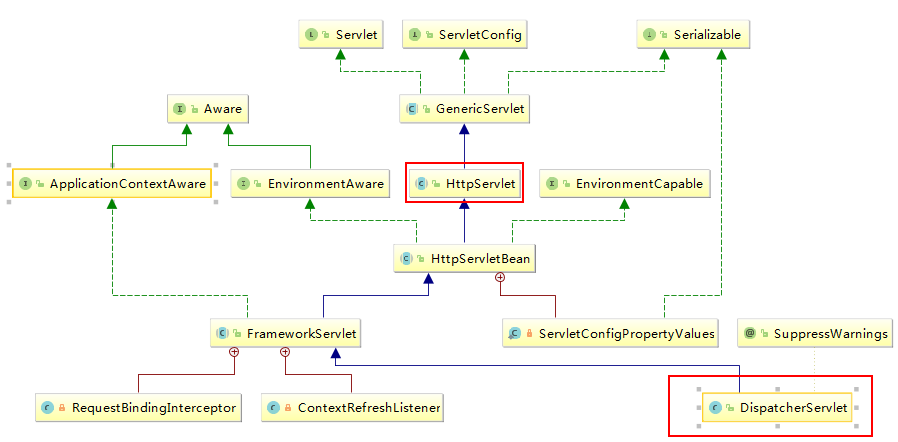
修改web.xml文件注册该Servlet,修改后的web.xml文件如下:
<?xml version="1.0" encoding="UTF-8"?>
<web-app xmlns:xsi="http://www.w3.org/2001/XMLSchema-instance"
xmlns="http://java.sun.com/xml/ns/javaee"
xsi:schemaLocation="http://java.sun.com/xml/ns/javaee http://java.sun.com/xml/ns/javaee/web-app_3_0.xsd"
id="WebApp_ID" version="3.0">
<!--注册servlet-->
<servlet>
<!--名称 -->
<servlet-name>springmvc</servlet-name>
<!-- Servlet类 -->
<servlet-class>org.springframework.web.servlet.DispatcherServlet</servlet-class>
<init-param>
<!--SpringMVC配置参数文件的位置 -->
<param-name>contextConfigLocation</param-name>
<!--这里是存放在resources目录下的springmvc-servlet.xml -->
<param-value>classpath*:springmvc-servlet.xml</param-value>
</init-param>
<!-- 启动顺序,数字越小,启动越早 -->
<load-on-startup>1</load-on-startup>
</servlet>
<!--所有请求都会被springmvc拦截 -->
<servlet-mapping>
<servlet-name>springmvc</servlet-name>
<url-pattern>/</url-pattern>
</servlet-mapping>
</web-app>
4.4、添加Spring MVC配置文件
在resource目录下添加springmvc-servlet.xml配置文件,配置的形式与Spring容器配置基本类似,为了支持基于注解的IOC,设置了自动扫描包的功能,具体配置信息如下:
<?xml version="1.0" encoding="UTF-8"?>
<beans xmlns="http://www.springframework.org/schema/beans"
xmlns:xsi="http://www.w3.org/2001/XMLSchema-instance"
xmlns:context="http://www.springframework.org/schema/context"
xmlns:mvc="http://www.springframework.org/schema/mvc"
xsi:schemaLocation="http://www.springframework.org/schema/beans
http://www.springframework.org/schema/beans/spring-beans.xsd
http://www.springframework.org/schema/context
http://www.springframework.org/schema/context/spring-context-4.3.xsd
http://www.springframework.org/schema/mvc
http://www.springframework.org/schema/mvc/spring-mvc-4.3.xsd">
<!-- 自动扫描包,实现支持注解的IOC -->
<context:component-scan base-package="com.zhangguo.springmvc01" />
<!-- Spring MVC不处理静态资源 -->
<mvc:default-servlet-handler />
<!-- 支持mvc注解驱动 -->
<!--在spring中一般采用@RequestMapping注解来完成映射关系,
要想使@RequestMapping注解生效必须向上下文中注册DefaultAnnotationHandlerMapping和一个AnnotationMethodHandlerAdapter
实例,这两个实例分别在类级别和方法级别处理。而annotation-driven配置帮助我们自动完成上述两个实例的注入。-->
<mvc:annotation-driven />
<!-- 视图解析器 -->
<bean
class="org.springframework.web.servlet.view.InternalResourceViewResolver"
id="internalResourceViewResolver">
<!-- 前缀 -->
<property name="prefix" value="/WEB-INF/view/" />
<!-- 后缀 -->
<property name="suffix" value=".jsp" />
</bean>
</beans>
在视图解析中我们把所有的视图都存放在/WEB-INF/目录下,这样是为了视图安全,因为这个目录客户端不能直接访问。
4.5、创建HelloWorld控制器
在src/main/java源代码目录下创建包com.zhangguo.springmvc01.controller,在包下创建一个普通的类:HelloWorld,具体代码如下:
package com.zhangguo.springmvc01.controller;
import org.springframework.stereotype.Controller;
import org.springframework.ui.Model;
import org.springframework.web.bind.annotation.RequestMapping;
/**控制器*/
@Controller
@RequestMapping("/hello")
public class HelloController {
/**动作,action*/
@RequestMapping("/hi")
public String hi(Model model){
//向模型中添加属性msg与值,将与页面模板渲染后输出
model.addAttribute("msg","Hello Spring MVC!");
return "hi";
}
}
注解为@Controller是为了让Spring IOC容器初始化时自动扫描到;@RequestMapping是为了映射请求路径,这里因为类与方法上都有映射所以访问时应该是/hello/hi;方法中声明Model类型的参数是为了把Action中的数据带到视图中;方法返回的结果是视图的名称hi,加上配置文件中的前后缀变成WEB-INF/view/hi.jsp。
4.6、创建视图
在WEB-INF/view目录中创建视图,hi.jsp视图将从Action中带回的信息展示,具体内容如下:
<%@ page contentType="text/html;charset=UTF-8" language="java" %>
<%@ taglib prefix="c" uri="http://java.sun.com/jsp/jstl/core" %>
<html>
<head>
<meta http-equiv="Content-Type" content="text/html; charset=UTF-8" />
<title>${msg}</title>
</head>
<body>
<h2>${msg}</h2>
</body>
</html>
4.7、配置TomCat部署项目
点击右上角的Edit Configurations添加对tomcat的配置:
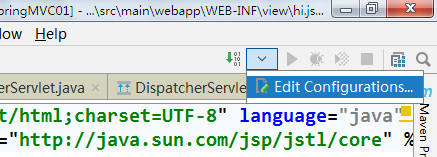
添加对tomcat的配置,设置名称,添加Deployment

可以设置context也可以没有,类似虚拟目录

4.8、测试运行
启动Tomcat运行项目,请注意查看启动信息,如果有异常应该先解决异常信息,运行成功后的结果如下所示:
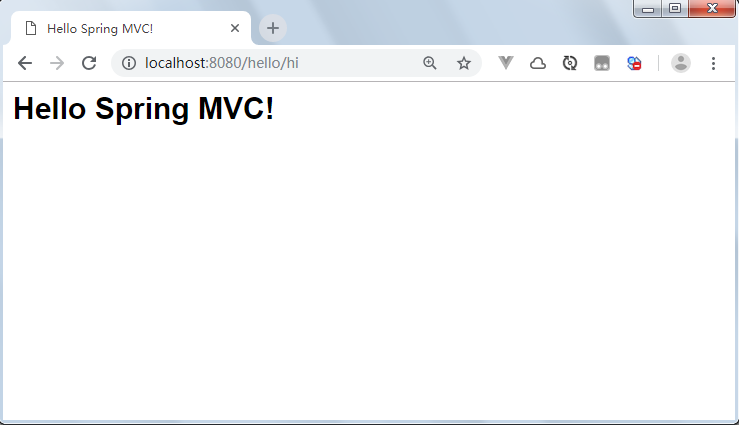
五、设置引导页
使用了spring mvc如果想直接访问控制器下的某个action为引导页,可以通过如下方式实现:
5.1、方法一
删除index.jsp默认引导文件
定义一下Home控制器,如下所示:
package com.zhangguo.springmvc01.controller;
import org.springframework.stereotype.Controller;
import org.springframework.ui.Model;
import org.springframework.web.bind.annotation.RequestMapping;
/**控制器*/
@Controller
@RequestMapping("/")
public class HomeController {
/**动作,action*/
@RequestMapping("")
public String index(Model model){
//向模型中添加属性msg与值,将与页面模板渲染后输出
model.addAttribute("msg","Welcome my website!");
return "hi";
}
}
结果:
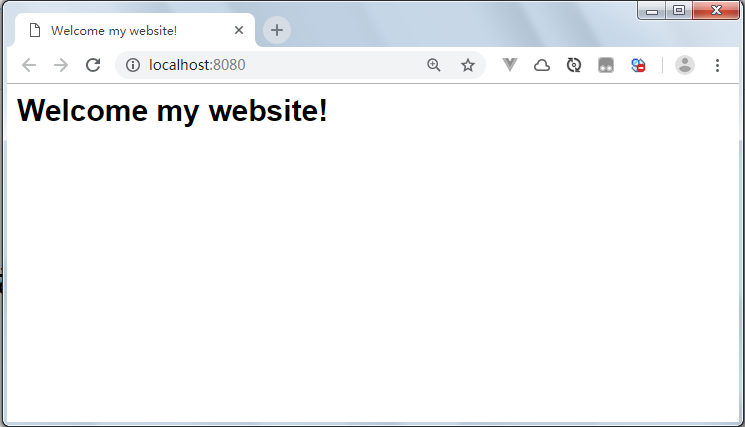
5.2、方法二
修改Spring MVC配置文件,增加如下配置:
<!--此标签用以在springMVC配置文件中实现路径的转发和资源的请求-->
<mvc:view-controller path="/" view-name="redirect:/hello/"></mvc:view-controller>
action如下:
package com.zhangguo.springmvc01.controller;
import org.springframework.stereotype.Controller;
import org.springframework.ui.Model;
import org.springframework.web.bind.annotation.RequestMapping;
/**控制器*/
@Controller
@RequestMapping("/hello")
public class HelloController {
/**动作,action*/
@RequestMapping("/hi")
public String hi(Model model){
//向模型中添加属性msg与值,将与页面模板渲染后输出
model.addAttribute("msg","Hello Spring MVC!");
return "hi";
}
/**动作,action*/
@RequestMapping("")
public String index(Model model){
//向模型中添加属性msg与值,将与页面模板渲染后输出
model.addAttribute("msg","Index Page!");
return "hi";
}
}
访问结果:

注意这种方法是使用的重定向方式,需发起两次请求,尽量转发。
六、示例下载
七、视频
八、作业
java遇见的问题分析
蓝桥杯练习
win7 在文件夹上右键后 以管理员启动命令窗口
渲染10万条数据的性能问题
闲聊一下百度的Unit
利用c# 多屏显示
学习Xposed --记WX功能分析的过程
从零开始打jar包--补充
修改windows7 的管理员密码
